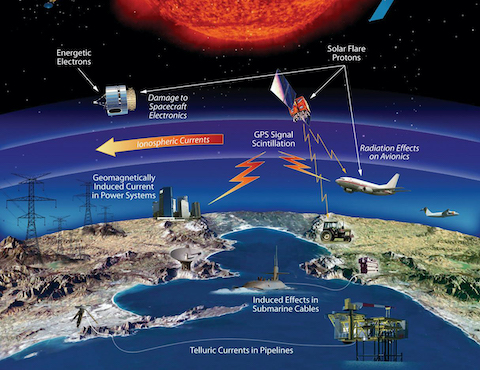
In other episodes, we talked about solar storms: electromagnetic radiation that flows from the Sun to Earth. In severe cases, they can disrupt our electricity and communication systems.
One very severe event happened a hundred years ago, in 1921, and lasted for 3 days when a large group of sunspots emitted bursts of plasma called coronal mass ejections.
Traveling a million miles an hour, these can take 1 to 3 days to reach Earth. Once here, their energy can create electrical currents that flow along conductive rocks, often jumping to phone and power lines.
In this 1921 event, electricity spiked to 1000 volts along telegraph wires, causing stations to burst into flames and rendering this communication network useless.
Severe solar storms hit earth about once a century, so we’re due for another one. In a much more interconnected world, what could happen this time?
Satellites could be affected, meaning we may temporarily lose GPS and other communication.
Airline passengers might be exposed to increased radiation, and airplane control systems could be impacted.
Modern infrastructure, internet, and electric grids—far larger than a century ago—could be especially at risk.
There are dozens of solar storms each year, but most are not aimed at Earth, so their energy travels into space. Still, scientists monitor solar activity closely to detect solar storms before they may reach Earth, allowing us time to prepare our systems.
Background
Synopsis: One hundred years ago, the most intense geomagnetic storm of the 20th century blasted Earth from May 13 to 15, 1921. Solar energy surged through conductive rock units and transmission lines, disrupting communication networks and setting fires. The Northern Lights stretched southward as far as Los Angeles, and auroras were seen in Samoa. Recently, this 1921 storm was re-categorized as a hundred-year storm. Investigation demonstrated it was one of the strongest solar storms ever recorded, rivaling the famous 1859 Carrington Event. These superstorms appear to recur every century. How would a solar superstorm impact civilization today?
- Geomagnetic storms emanate from complex sunspot groups that track across the Sun’s surface. Their effects take some time to reach Earth and can be monitored.
- Previous EarthDate episodes focused on sunspots and solar cycles and magnetic storms.
- Solar flares look like bright flashes of light and erupt regularly from sunspots. Traveling at the speed of light, their energy takes 8 minutes to reach Earth, where it can be detected in radio, optical, and X-ray wavelengths.
- Highly energetic particles arrive a few minutes later and may continue for hours, sometimes disrupting radio waves. Multiple eruptions may cause these effects to last for days.
- Coronal mass ejections (CMEs) are plasma clouds that explode out of the Sun like cannonballs. Solar flares often precede or coincide with CMEs.
- These pulses of solar matter travel at more than a million miles per hour (light travels 671,000,000 miles per hour), taking 15–72 hours to get to Earth depending on the speed of the CME, the distance to Earth, the orientation of magnetic fields in the CME, and the speed of the solar wind ahead of the CME.
- These events funnel particles into near-Earth space, impacting Earth’s magnetic field and degrading radio waves and GPS signals.
- Upon reaching Earth, strong CMEs may produce geomagnetically induced currents (GICs) that run along the most conductive near-surface path, ranging from earth materials to manmade utility grids.
- You may remember a recent geomagnetic storm that occurred on March 13, 1989, causing a 9-hour blackout for 6 million people in Quebec and more than 200 less severe power grid issues in the United States.
- Some satellites tumbled out of control for hours, and transmissions from GOES weather satellites were interrupted.
- Launching from the Kennedy Space Center the same day, the Space Shuttle Discovery reported anomalous sensor readings but was not otherwise affected.
- A century ago, on May 12, 1921, a huge sunspot crossing the Sun began to erupt, hurling repeated coronal mass ejections directly at Earth for the next 3 days, packing up to 10 times the disturbance level measured during the March 1989 storm.
- The energetic pulses generated geomagnetically induced electrical currents that coursed along the Earth’s surface, jumping to electrical, telephone, and telegraph lines.
- Voltages spiked as high as 1000 volts on some U.S. telegraph lines. Communication was also disrupted in Australia, Brazil, Canada, Denmark, France, Japan, New Zealand, Norway, Sweden, and the United Kingdom.
- Some telegraph machines in Europe and New York burst into flames. Two railroad buildings in New York State burned to the ground, so the event is often referred to as the “New York Railroad Superstorm.”
- During the peak of the storm on May 15, the Northern Lights extended as far south as Los Angeles, central Texas, and Atlanta, while red auroras lit equatorial skies and were visible from the South Pacific island nations of Tonga and Samoa.
- While most equipment around the globe was rendered useless by being pegged out to maximum values, several stations in Kakioka, Japan, and Apia, Samoa, did not go off the scale.
- Calculations from these sites showed that the intensity of this 1921 storm was as strong as the historic 1859 Carrington Event, which sparked auroras over Cuba, the Bahamas, and Hawaii; set fire to telegraph stations; and was long thought to have been the largest solar storm ever.
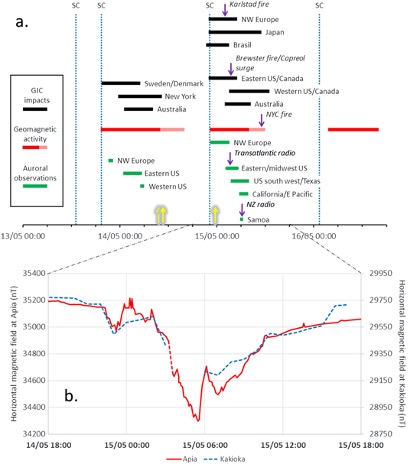
- Recently, researchers have demonstrated that events like the 19th-century Carrington Event and 1921 superstorm are not unique—a major superstorm that occurred in the 18th century may have been even larger.
- Asian historical records from 1770 document 9 days of bright red auroras in mid-September. While exploring Timor Island south of Indonesia, Captain Cook described the same red auroras in his ship’s log.
- Drawings by Chinese astronomers of the sunspot that sourced the 1770 geomagnetic storm suggest it may have been twice the size of the Carrington sunspot.
- Additional events during previous centuries have also been hypothesized from sketchy historical records.
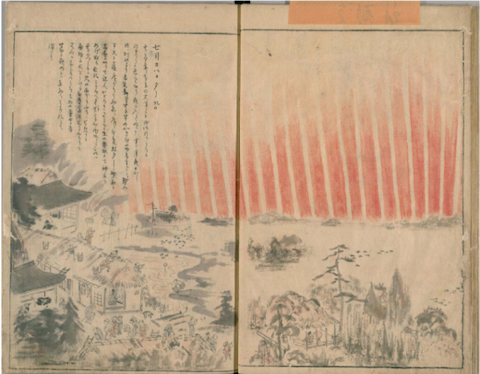
- Recently, scientists have documented the geomagnetic storm near-misses that occur when the solar “artillery” is not aimed directly at Earth.
- In July 2012, NASA and European space agencies witnessed a potentially devastating solar superstorm that barely missed Earth.
- Superstorms with the strength of an event like the 1921 storm are believed to occur about once a century and are referred to as “Carrington-class” CMEs.
- The Sun produces dozens of these strong CMEs each century. Most are aimed away from Earth or have magnetic field orientations less effective at penetrating Earth’s magnetosphere than the southward orientation characteristic of Carrington-class events.
- Impacts of solar superstorms have increased as the infrastructure footprint of our civilization has grown.
- In 1770, the geomagnetically induced currents (GICs) travelled through natural rock, so the main impacts on civilization were the beautiful bright red auroras.
- In 1859, GICs jumped up into telegraph lines, and in 1921, GICs coursed along electrical, telephone, and telegraph lines, resulting in damaging fires. Both events also featured spectacular auroras.
- Scientists have long struggled with the impending concern of what would happen if a once-in-a-century solar superstorm were to happen today.
- Loss of radio-based technologies like GPS would have significant impacts on emergency services and logistics.
- Profound changes could occur to satellite orbits.
- Airline and space travelers may be exposed to extra radiation, and avionics systems like airline engine control may be impacted.
- Modern infrastructure and electrical grids, including wind generation and solar arrays, are orders of magnitude larger than a century ago and are strongly interconnected to support contemporary lifestyles.
- A region’s geomagnetic power grid vulnerability depends on how power lines are configured in the area and the properties of the ground itself.
- In areas with resistive igneous bedrock like Quebec, GICs leap from the ground into more conductive metal power transmission lines, spreading quickly over the sprawling grid.
- Strong GICs may blow fuses, trip circuit breakers, and melt transformers.
- GICs can also run along railways, pipelines, and undersea communication cables.
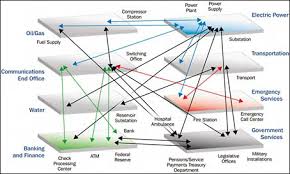
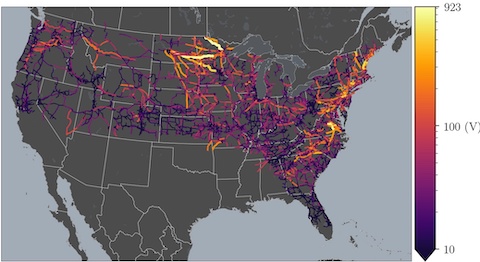
- The next solar superstorm is coming, but dedicated global space weather scientists monitor solar activity constantly to provide alerts that will trigger shutdowns and mitigation efforts to minimize impacts.

